Is selling on Amazon worth it in 2025? Yes. It’s the first question every new entrepreneur asks. With 9.7 million registered sellers worldwide, independent Amazon sellers made more than $290,000 in sales last year.
However, understanding the algorithm, fees, and policies is crucial to surviving the ever-competitive market. With Amazon, you can start churning profits in under three months. This article will explore the in-depth details of beginning as an entrepreneur on Amazon.
You can be profitable within 2–3 months for well-prepared sellers, with potential profit margins of 15–50% depending on the business model. However, high competition, variable fees, and strict policies demand careful planning.
What are the Pros and Cons of Selling on Amazon?
Starting on Amazon comes with benefits and drawbacks. Here is a quick overview of the pros and cons of selling on Amazon:
Pros of Selling on Amazon
- Reliable and Expansive clientele: Amazon has an inherent customer trust. Local and global customers see Amazon as a reliable platform for buying products. Selling on Amazon exposes your products to a broad and repeat customer base
- Growing Potential: Amazon is a strong online marketplace with unmatched potential to become a business giant, ensuring lucrative potential for sellers as well.
- Start without Infrastructure: For new entrepreneurs, Amazon helps build a strong brand with services like FBA, which manages customer service, inventory, and shipping. Sellers can solely focus on marketing instead of managing warehouses and logistics.
- Ranking in SEO: Amazon has a high ranking on search engines, which makes your product more likely to appear directly on those engines.
Cons of Selling on Amazon:
- Competition for Visibility: Multiple entrepreneurs selling the same product create competition for visibility, making it difficult for new entrepreneurs to stand firm and maintain consistent sales.
- Amazon Fees: From starting new on Amazon to selling on FBA and referrals, Amazon has a list of fees. Learn more about it in detail in the fee section.
- Policies and Suspension: Amazon enforces strict product policies for quality control. Sellers who don’t comply risk account suspension, and repeated violations can reduce brand visibility.
Risks of Selling on Amazon:
- Amazon Saturation: Amazon is crowded with sellers offering the same products at different prices, creating intense competition and limited chances for brand recognition. Businesses with small inventories often struggle to survive in this saturated marketplace.
- Package Returns: Amazon is more customer-oriented than sellers. Buyers who do not like a product can easily return it. Businesses face a higher product return frequency on Amazon and have to bear the return charges.
- Reliance on Amazon: Relying solely on Amazon as your primary business model is risky. Sudden account suspensions or inventory issues can quickly cut sales and hurt rankings.
Amazon’s 2025 Changes and Their Impact on Sellers
There have been some considerable changes in Amazon’s operations in 2025.
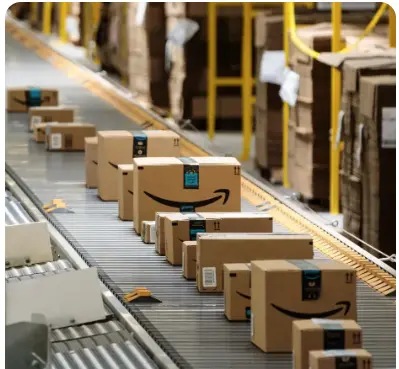
Taxes and Tariffs
Trump’s tariff announcement for Chinese products has strained buyers. Any Chinese product worth over $800 will face a significant tariff of as high as 145%. Most businesses that bulk-import Chinese goods and sell on Amazon have faced drastic business shifts. Fewer sellers are willing to participate in Prime Day discounts and offer any deals.
Damaged Product Reimbursement
Amazon has revised its damaged product policy. As per the change, since 31st March, any damaged or lost inventory item will be reimbursed at the manufacturing price rather than the sale price. This is a major blow to businesses previously compensated for lost/damaged goods.
Inclination towards Third-Party Apps
But not everything new in 2025 is related to Amazon. Top sellers pair their brands with third-party platforms like Facebook and TikTok to expand reach and attract new customers. Many use TikTok Live for promotions and discounts, driving sales and building a global audience.
AI Integrated Smart Selling
Amazon has launched Project Starfish, an AI tool to help businesses with listings, product descriptions, and sales boosting. It helps businesses catalog and increase visibility. The automotive bot tool is predicted to raise sales by $7.5 billion in 2025.
While researching this topic, I came across an interesting discussion on Reddit where users shared insights about Amazon Fulfillment Centers and their locations.
Amazon Fulfillment Centers and where are the located
byu/jordiobdotcom inAmazonTools
Amazon Seller Fees in 2025
For entrepreneurs beginning to sell on Amazon, here is a complete breakdown of fees to pay:
- Professional Selling Plan: $39.99/month (recommended for most sellers; Individual plan at $0.99 per item sold is less common).
- Referral Fees: 8–15% of the sale price, varying by category (e.g., 15% for electronics, 8% for books).
- Media Closing Fee: $1.80 per item for books, DVDs, music, and software.
- FBA Fulfillment Fees: Variable, based on product size/weight (e.g., $2.29–$6.15 for standard-sized items up to 20 lb).
- FBA Storage Fees: $0.78/cubic foot (Jan–Sep) or $2.40/cubic foot (Oct–Dec); aged inventory fees apply for items stored over 181 days.
- FBA New Selection Program: Zero inbound placement fees for the first 100 units per ASIN for eligible new products.
- Other Costs: Potential fees for returns, removals, or deal promotions. Use Amazon’s Revenue Calculator for precise estimates.
Also, Amazon may charge you for your products, such as an aged inventory penalty, damaged items, or deal fees. Therefore, you must have an idea of your product dimensions and box size to avoid overcharges by Amazon. To learn more about Amazon’s fee changes, visit Amazon Seller Central for updated fee revisions.
Is Amazon Worth It for Your Business Model?
Amazon offers different selling models to accommodate businesses on the platform. Here is a detailed breakdown of the Amazon selling models:
1. Wholesale
Wholesale model means getting products in bulk and selling them for a profit on Amazon. Selling wholesale on Amazon is worth it for its scalability and profit margins. Sellers sell already established and in-demand products, lowering the need for rigorous marketing. However, a startup cost is needed to start.
Costs:
- Initial Inventory: $2,500–$10,000 (varies by product/volume).
- Licensing/Sales Tax Permit: $0–$500 (location-dependent; e.g., free in Oregon, up to $500 in California).
- Amazon Fees: $39.99/month (Professional plan) + 8–15% referral + FBA fees (~$2–$6/unit + storage).
2. Retail Arbitrage
Retail Arbitrage is a more simplified version of wholesale, where sellers pick up products from Walmart, Target, or Costco at discounted prices or promotions. They later sell it on Amazon for a markup. The investment size is small for the retail arbitrage mode but offers excellent profitability. However, product authenticity is challenged because no manufacturers are involved. This can often result in Amazon restrictions and strikes.
Costs:
- Initial Inventory: $200–$1,500
- Tools (e.g., scanning apps): $20–$100/month
- Amazon Fees: Same as above; Individual plan ($0.99/item) viable for low volume
3. Online Arbitrage
Sellers buy products from click-and-mortar stores or online retailers like AliExpress and AliBaba and sell items for a profit on Amazon. The business model works entirely through the web, where sellers pick items from one online store and sell them at another. The investment is small but brings bigger profits.
Costs:
- Initial Inventory: $100–$1,000.
- Arbitrage Tools: $20–$150/month.
- Amazon Fees: As above; factor in supplier shipping costs.
- Private Labels:
This selling model focuses on generic or self-manufactured products sold under a trademarked or registered brand. It requires a high investment to manage marketing and inventory. However, the sales return is strong because sellers own the brand and control pricing.
Costs:
- Initial Setup (manufacturing, trademark): $3,000–$12,000
- Packaging: $500–$2,000
- Amazon Fees: As above; add $500–$2,000 for PPC ads at launch
Pro tip: Apart from the above costs, you also consider the Amazon advertising costs. If you are planning to run ads on this platform, these costs can heavily affect your profit margin.
FBA vs. FBM: Choosing the Right Fulfillment Path
Amazon offers two ways to complete orders: FBA (Fulfillment by Amazon) and FBM (Fulfillment by Merchant). Here is a quick comparison between the two.
| FBA (Fulfillment by Amazon) | FBM (Fulfillment by Merchant) |
| Orders are packed, shipped, and handled by Amazon. | Orders are packed, shipped, and managed by the seller. |
| Less control over your brand. | More autonomous over inventory and product packaging. |
| Amazon manages Customer Service. Products are automatically entitled to express delivery (Amazon Prime). | Customer service is handled by the Merchant. |
| No inventory warehouses needed, but higher costs. | Need warehouses for product storage at a lower cost. |
What Sellers Can Do Differently Now for More Gains on Amazon?
To survive in the ever-competitive market, sellers need to be smart. Here is how sellers can adapt for sustainability:
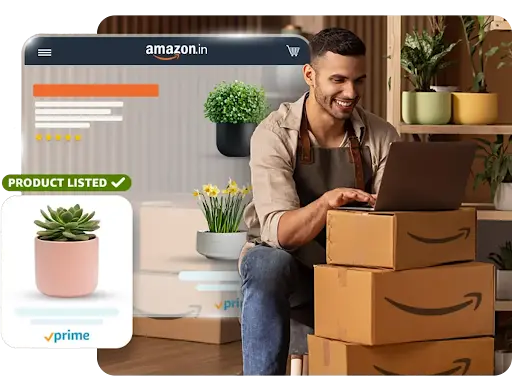
- Improve Product Listings
Refine how your product appears to customers. For a strong listing, use clear headings with a detailed product description. Buyers are attracted to clear visuals, reviews, and testimonials. Use AI services like Amazon’s Project Starfish to improve listings and reach the target audience. Leverage services like Amazon PPC management to increase your product visibility.
Pro tip: Learn 12 top-notch Amazon PPC advertising tips to ensure you get more sales, more product boost, and improve the listing.
- Linking with Third-Party Applications
Relying solely on Amazon to make your product stand out is tough. To drive traffic, link and market your products on third-party applications like TikTok, Facebook, and Instagram. Sellers can use affiliate marketing and influencer PR to strategize against their competitors.
- Eco-friendly Packaging
Some merchants have shifted to eco-friendly packaging to appeal to eco-conscious customers. Amazon’s Climate Pledge Friendly program awards certifications to such sellers, resulting in better visibility and higher traffic conversions.
Startup Capital & Timeline for Beginning at Amazon
As an entrepreneur who is ready to take off with Amazon, here are the estimated costs and a timeline overview:
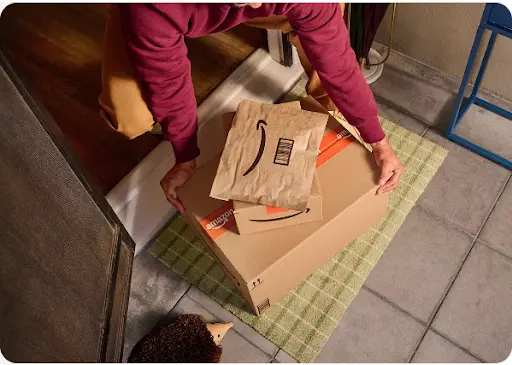
Startup Investment
The initial investment depends on your choice of business selling model, Amazon fees, and some additional costs.
- Amazon Seller account fee.
- FBA/FBM fee.
- Referral fee. ( charged ~15%)
- Product photography.
- Marketing budget.
- Brand trademark.
- Influencer endorsement budget.
- Analysis and Software Tools.
Timeline
- Set up an account on Amazon: ~ 1-2 weeks.
- Build an Inventory: ~ 7-10 weeks.
- Product Listing: 2-3 weeks.
- Generate First Sale: ~ 4-6 weeks.
Generally, merchants can start generating profits within 60 days of brand launch. Initially, the margins are small, approximately 10-15%. However, as per a survey, Amazon sellers can profit 20% or higher.
How to Start Selling on Amazon?
Below is a brief guide to help you start selling on Amazon.
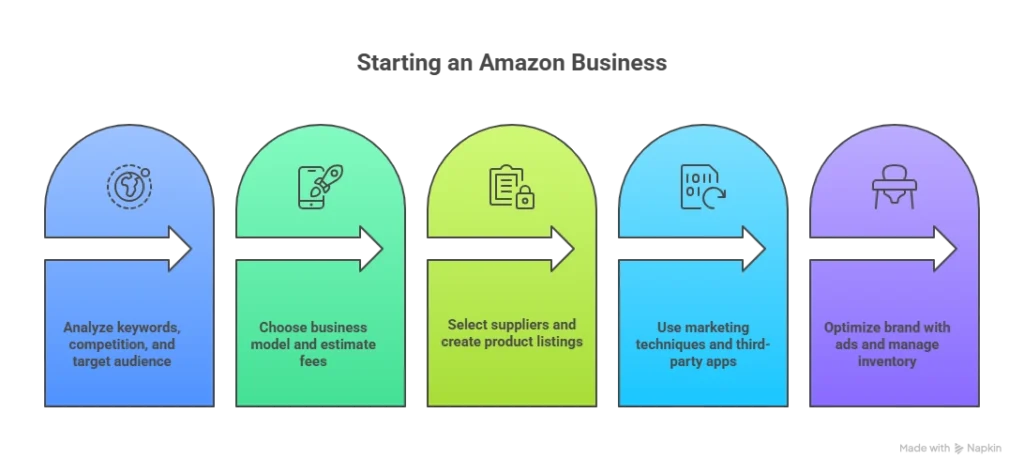
- Understand the Market
Begin by analysing the keyword, market, and competition for your niche. Understand the target audience and SEO ranking to create strong product listings. Use PPC audit to review competitors’ listings and keyword research.
- Calculate the Cost and Investment
Choose your business model and understand the initial investment and Amazon fees. Use a cost calculator to estimate the initial fees for creating an account, referral, and FBA.
- Building an Inventory
Choose a reliable supplier to source high-quality but cheap products. Build an inventory with FBA or FBM. Create targeted, strong product listings with sharp visuals.
- Marketing and Generating Traffic
Adopt strategic marketing techniques to build a strong brand profile. You can integrate third-party apps to draw in traffic and achieve effective conversions. Use samples and influencer testimonials to build credibility. Sponsored products listing is a great way for more traffic.
- Post-Launch Brand Management
Optimize your brand with ads, promotions, and competitive pricing. Inventory operators are used to manage stock levels, especially for fast-selling products.
Alternatives to Selling on Amazon
Amazon’s strict policies and suspension rules allow businesses to explore other competitive alternatives. Here are a few great alternatives to start your e-commerce journey:
Etsy is an online platform especially focused on handmade, unique goods. It’s ideal for sellers with a small handicraft business or private label products. Due to crowding, the competition is higher, but sellers have more autonomy over their brand.
- Market for vintage, generic, handmade goods.
- Doesn’t handle logistics, but sellers can employ third-party services.
- Lower fees than Amazon.
Walmart offers an open marketplace for merchants to directly sell goods alongside their own inventory. Walmart’s trusted presence helps products gain a reliability check and a global reach. Walmart also offers fulfillment services to ensure thorough customer care and logistic handling.
- Walmart Fulfillment Services will handle logistics, shipping, and customer care.
- Lower fee than Amazon.
- Strong competition from Walmart products.
- Lesser brand visibility than Amazon.
A small e-commerce platform to build your own online business from scratch. Shopify offers extensive third-party integrations to draw in business traffic. Shopify offers room for scalability and complete autonomy to lead your brand.
- Businesses have to generate traffic themselves.
- Access to customer data.
- No competition from other merchants.
- $39 monthly subscription with other fees.
Frequently Asked Questions
- Can I start selling on Amazon without inventory?
Yes. You can sell on Amazon without a physical inventory through Drop shipping or Merch by Amazon.
- Do I need an LLC to sell on Amazon?
No. You can register as a sole proprietor. However, an LLC is recommended for expensive products or for those registering with the FBA programme.
- Is FBM cheaper than FBA in 2025?
No. The cost-effectiveness between the two depends on factors like sales volume, already established logistics, and fast-selling products. It is cheaper when you have strong logistics or sell high-value products.
- How long until my business becomes profitable on Amazon?
It takes under three months to earn a profit on Amazon. However, there is no fixed date. The profitability period depends on your product selection, marketing, pricing, and the customer response.
Conclusion
Selling on Amazon in 2025 offers significant profit potential but requires navigating high competition, variable fees, and new policies like tariffs and inventory reimbursement changes. Choose a business model (Wholesale, Arbitrage, or Private Label) that aligns with your budget and goals, optimize listings with AI tools like Project Starfish, and diversify traffic via social media.
To stay competitive, choose your business selling model and understand the product market. Use Amazon PPC Audit to analyze profits and losses and improve SEO ranking.

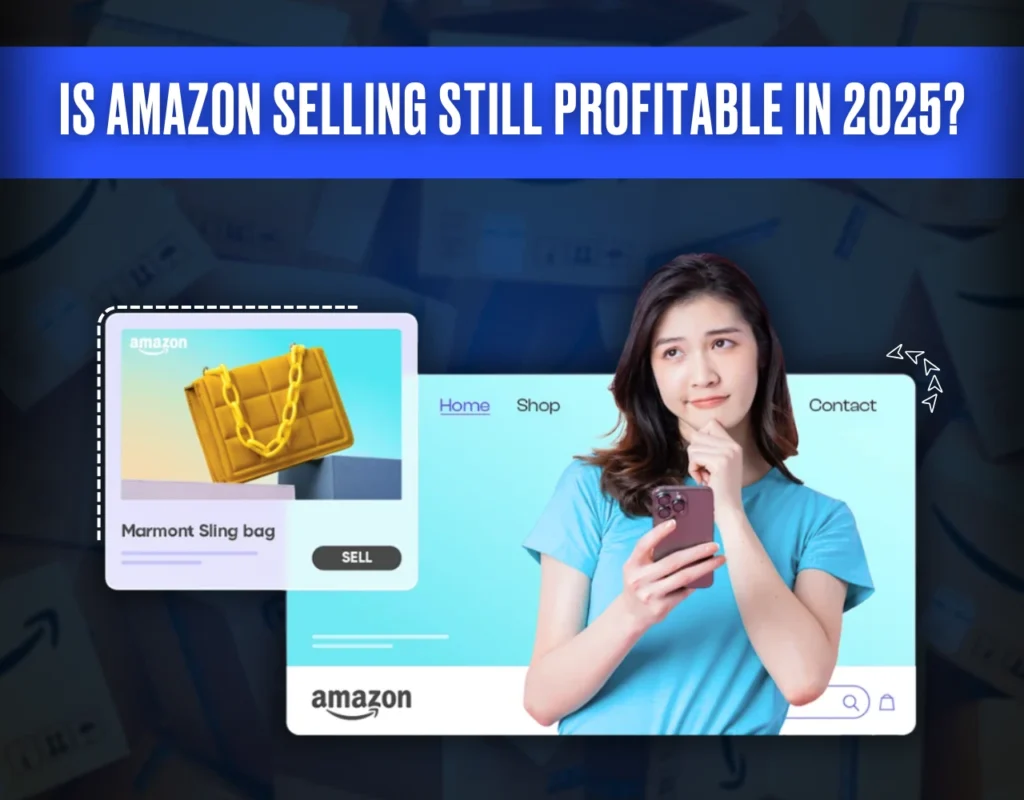

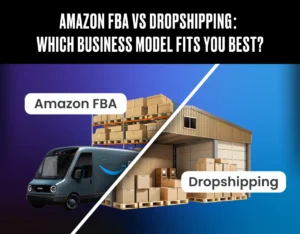
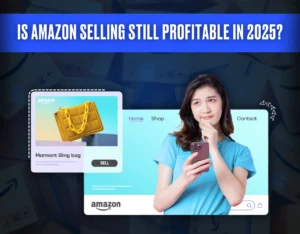

One Response
Great breakdown of the pros and cons of selling on Amazon. The point about understanding fees and competition before starting is a solid reminder for anyone considering the platform.